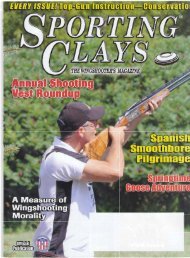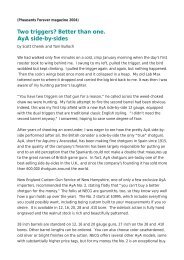. Cat.logo_AYA(1-15).fh8 - AYA, Aguirre y Aranzabal
. Cat.logo_AYA(1-15).fh8 - AYA, Aguirre y Aranzabal
. Cat.logo_AYA(1-15).fh8 - AYA, Aguirre y Aranzabal
Create successful ePaper yourself
Turn your PDF publications into a flip-book with our unique Google optimized e-Paper software.
The Basque Country<br />
And the Ancient Art of Gunmaking<br />
T<br />
he Basque Country consists of three provinces in northeastern Spain, with the<br />
Pyrenees to the east and the Bay of Biscay to the north. It is a land of steep green<br />
mountains, hidden valleys, and rugged coastlines.<br />
The Basque Country — El Pais Vasco — is an ancient land, and its inhabitants have dwelt<br />
in its mountains since the dawn of mankind. The Basques are believed to be the last of<br />
the original Europeans, with their own language and unique culture. They are seafarers<br />
and fishermen. Fishing villages dot the coast like pearls, and great navigators have sailed<br />
from Basque ports to explore every corner of the earth.<br />
With a wealth of water power and substantial iron deposits, however, the Basque Country<br />
is also an ancient industrial centre. Steelmaking and manufacturing have been mainstays<br />
of the Basque economy for centuries.<br />
From the beginning, the Basques were great arms makers. They began with swords, spears<br />
and shields, and graduated naturally to gunmaking when gunpowder was discovered<br />
and the technology swept through Europe in the late 1200s. The center of Basque<br />
gunmaking is the town of Eibar, situated in a narrow mountain valley cut by the Ego<br />
River.<br />
For centuries, gunmaking has been the raison d’être for Eibar’s 28,000 inhabitants. It is<br />
home to the Escuela de Armeria — the gunmakers’ school — as well as the government<br />
proof house (Banco de Pruebas) which proof-tests every shotgun made in Spain.<br />
– 7 –<br />
Spanish Treasure<br />
The era of fine gunmaking in the English tradition began in the Basque Country during<br />
the Peninsular War, when Napoleon’s troops were driven out of Spain by Spanish guerrillas<br />
and British forces under the Duke of Wellington. Wellington’s officers took home gun<br />
barrels of Spanish steel (Spanish steel was renowned for its strength) and had them made<br />
into fowling pieces by London gunmakers such as the Manton brothers.<br />
This gave birth to a strong bond between London, the commercial capital of the world,<br />
and Bilbao, the Basque port and center of banking, shipping, and iron mining.<br />
The Basques shipped iron ore to Britain, and sailed home with cargos of British coal. The<br />
close commercial ties between London and Bilbao throughout the 1800s naturally led<br />
to exchanges of technology and technique; as the English perfected the game gun in the<br />
late 1800s, the passion for fine guns crossed the Bay of Biscay and established itself in<br />
the Basque Country.<br />
If John Manton was the father of English gunmaking — making artists out of blacksmiths,<br />
as James Purdey described it — then Victor Sarasqueta was the father of the Basque finegun<br />
trade. Sarasqueta established his company in 1881, and for the next hundred years<br />
set a high standard for Spanish “best” guns. Although Sarasqueta was the oldest, however,<br />
his company was not the largest, nor was it the most famous.<br />
That honour belongs to a firm founded in 19<strong>15</strong> by Miguel <strong>Aguirre</strong> and Nicolas <strong>Aranzabal</strong><br />
— <strong>Aguirre</strong> y <strong>Aranzabal</strong>, known around the world as <strong>AYA</strong>. ✦




